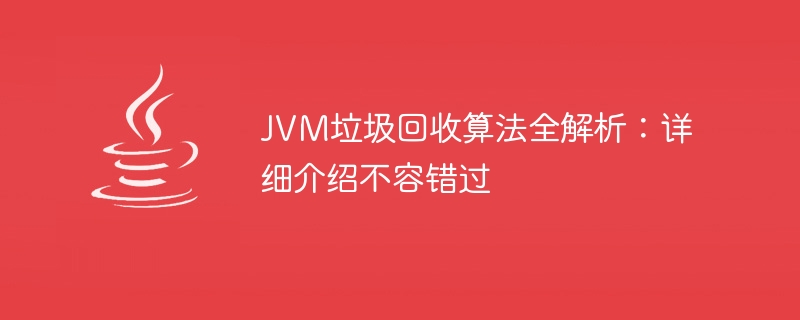Home >Java >javaTutorial >Full analysis of JVM garbage collection algorithm: a detailed introduction not to be missed
Full analysis of JVM garbage collection algorithm: a detailed introduction not to be missed
- WBOYWBOYWBOYWBOYWBOYWBOYWBOYWBOYWBOYWBOYWBOYWBOYWBOriginal
- 2024-02-20 23:57:04811browse

Full analysis of JVM garbage collection algorithm: Detailed introduction is not to be missed, specific code examples are required
Introduction
JVM (Java Virtual Machine) is to execute Java Bytecode virtual machine. During the running of a Java program, the JVM is responsible for memory management, of which the garbage collection algorithm is an important part. This article will introduce the JVM's garbage collection algorithm in detail and provide specific code examples to help readers better understand and master this key concept.
1. Overview of garbage collection algorithm
The garbage collection algorithm is the core tool of JVM for memory management. Its main goal is to automatically discover and reclaim memory space that is no longer used by the program, thereby releasing memory resources and improving program performance and stability.
Common garbage collection algorithms include the following:
- Reference Counting: This is a simple garbage collection algorithm that maintains a A reference counter that records how many references currently point to the object. When the reference counter reaches 0, it means that the object is no longer used by the program and the memory can be reclaimed. However, reference counting cannot solve the problem of circular references.
- Mark-Sweep: This is a basic garbage collection algorithm. It is divided into two phases: marking phase and clearing phase. In the marking phase, the garbage collector will start from the root object, recursively traverse the object graph, and mark the active objects. During the cleanup phase, the garbage collector cleans and recycles unmarked objects.
- Copying algorithm (Copying): This is a garbage collection algorithm suitable for the new generation. It divides the memory into two equal-sized areas, namely the From area and the To area. In the new generation, most objects have a short life cycle, so only live objects need to be recycled. The copy algorithm implements garbage collection and memory organization by copying active objects from the From area to the To area.
- Mark-Compact algorithm (Mark-Compact): This is a garbage collection algorithm suitable for the old generation. It combines the advantages of mark-sweep and replication algorithms. First, through the marking stage, the active objects are marked. Then, through the defragmentation phase, these live objects are sorted to one end of the memory so that memory fragmentation after recycling is minimized.
2. Garbage collection algorithm example
The following is a simple Java code example that demonstrates the copy algorithm and mark-sweep method in the garbage collection algorithm:
public class GCExample {
private static final int MB = 1024 * 1024;
public static void main(String[] args) {
Object obj1 = new Object();
Object obj2 = new Object();
Object obj3 = new Object();
// 标记阶段
obj1 = null;
// 清除阶段
System.gc();
// 复制算法
byte[] array = new byte[2 * MB];
}
}In the above code, we created three objects and set obj1 to null during the marking phase. During the cleanup phase, we manually called the System.gc() method to trigger garbage collection. Finally, the copy algorithm is demonstrated by creating a byte array of 2MB size.
3. Summary
This article introduces the JVM garbage collection algorithm in detail and provides specific code examples. The garbage collection algorithm is a key part of JVM memory management and is crucial to the performance and stability of Java programs. Understanding and mastering different garbage collection algorithms can help developers optimize the memory usage and execution efficiency of programs.
I hope this article can help readers understand the JVM garbage collection algorithm and apply it to actual development. Writing efficient and stable Java programs takes us one step closer to optimizing memory usage and improving performance.
The above is the detailed content of Full analysis of JVM garbage collection algorithm: a detailed introduction not to be missed. For more information, please follow other related articles on the PHP Chinese website!

